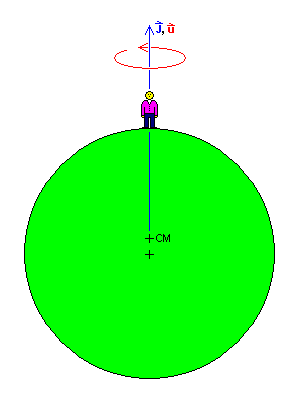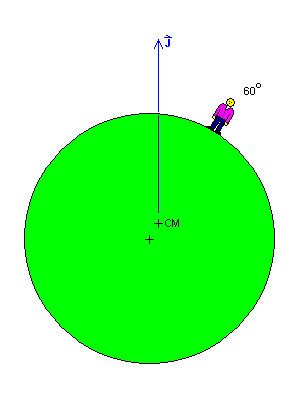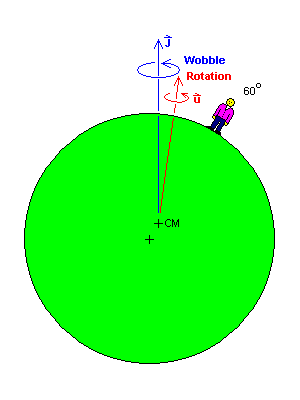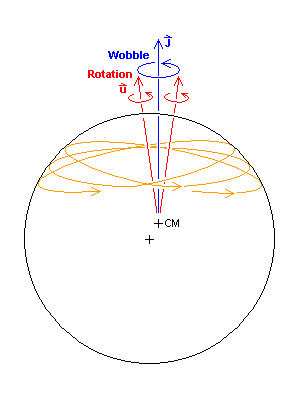Changing a Planet's Rotation from Within
Steven Dutch, Professor Emeritus, Natural and Applied Sciences, University of Wisconsin - Green Bay
It's not totally correct to say that nothing acting from on or within a planet can change its rotation. There are some things about the rotation that cannot change, period, but changes to the planet's rotation rate and axis orientation are possible. Let's start by looking at a well-known children's classic.
The Little Prince
 | Antoine St. Exupery’s book The Little Prince has a devoted following not just among children, but among aviators (St. Exupery was a pioneer in aviation who died on a mission in 1944 during World War II) and astronomers. The namesake of the book came to Earth from B-612, a tiny asteroid barely the size of a house, visiting several other equally tiny asteroids and their peculiar inhabitants on the way. We’ll avoid such tedious and sensible grown-up questions about how such a tiny asteroid has enough gravity to hold the Little Prince, or what he breathes, or where he gets his groceries, goes to the bathroom, etc. We’ll just focus on what happens as the Little Prince walks around on his asteroid. Imagine for starters that the Little Prince is standing exactly on the pole of his asteroid as it turns on its axis. The drawing is not of the Little Prince in the book, because while The Little Prince may be a book for children, the copyright is guarded by very sensible, grown-up and altogether humorless lawyers. He’s standing so that his center of mass is right on the axis of the asteroid. As long as he stands there, the asteroid can rotate smoothly on its axis (Note 1). But what happens if he moves? |
The Little Prince can affect the rotation of his asteroid by moving around. The two things he cannot change are the rotational kinetic energy of the asteroid and its angular momentum (J). The Little Prince's asteroid is moving around the sun. It has linear momentum and kinetic energy. Those can't change unless some external force acts on the asteroid. The asteroid also has momentum and energy because it is spinning. Think of a playground carousel. You have to run and push on it to get it spinning, and once it is spinning it takes effort to stop it. If there are a dozen kids around the rim, it is harder to get it moving and harder to stop it, but if they're all bunched in the center, it takes hardly more effort than if the carousel is empty. So it's not just the mass of the carousel, but how it's distributed that's important.
Angular Momentum and Moment of Inertia
Momentum and energy for rotating bodies have formulas very similar to the familiar formulas for linear kinetic energy and momentum. For an object moving in a straight line with velocity v, the kinetic energy is E = ½ mv2 and the momentum is p = mv. For a rotating object, the formulas are quite similar. For velocity, we have rotational velocity, which we’ll call u, expressed as angle per unit time. Angle is measured in radians. There are 2π = 6.283… radians in 360 degrees. Instead of mass, we have a quantity called moment of inertia, usually abbreviated I, which is a measure of how mass is distributed around its rotation axis. So the rotational energy of the asteroid (plus the Prince) is E = ½ Iu2 and the angular momentum is J = Iu. As long as the asteroid and the Little Prince don’t interact with anything else, their angular momentum and rotational kinetic energy cannot change.
If the asteroid is a sphere, its moment of inertia is given by I = 2/5 mr2. In general, the moment of inertia of any object is some constant times the mass times its size squared. (It is one of the oddities of physics that you expect a basic shape like a sphere to have some nice neat constant like 1 or ½, and instead we get this oddball coefficient of 2/5.) So let’s assume the asteroid is 1.3 meters in radius and has a density of 3000 kg/m3. The volume of the asteroid is 4/3 πr3, or 10 cubic meters, so its mass m is 30,000 kilograms. So the total moment of inertia is I = 2/5 mr2 = 21,000 kg-m2. If the asteroid revolves in just a bit over ten minutes (the Little Prince once watched 44 sunsets in a single day just by moving his chair), its angular velocity is 0.01 radian/second and its kinetic energy is E = ½ Iu2 = 1.05 joules. Its angular momentum is J = Iu = 2100 kg-m2/sec. The title of the book is The Little Prince, so let’s assume he weighs 30 kilograms and his center of mass is 0.5 meters off the ground. He weighs 1/1000 as much as the asteroid and his center of mass is fully 0.27 radius off the ground. The whole point of this exercise is that the Little Prince is pretty big compared to his home world, big enough to have a measurable effect on its rotation. His mass is enough to displace the center of mass of the system (him and the asteroid) by about two millimeters. In the diagram above, CM is the center of mass, and the displacement is greatly exaggerated.
Angular velocity and angular momentum are both vectors; they have magnitude and direction. The direction of angular velocity is along the rotation axis. If the object is a perfect sphere, the angular momentum vector is also along the rotation axis. Now comes the tricky part. Linear velocity and linear momentum always have the same direction, but angular velocity and angular momentum don't have to. One very common way this can happen is for an object to be rotating around multiple axes simultaneously - a slow-flying, wobbling Frisbee® is a perfect example. What never changes for a planet, as long as no outside force is involved, is the angular momentum vector. Unfortunately, you can't see the angular momentum vector whereas you can see angular velocity and the rotation axis.
To see how angular velocity can change, recall the formula for angular momentum, J = Iu. I is the moment of inertia and it depends on how mass is distributed within the planet. J is what never changes, but if you change I, u (angular velocity) will change to keep J constant. You can change I by redistributing mass. The most familiar example is an ice skater whose spin speeds up as she draws in her arms. If the ice skater extends her arms in front, she'll continue to spin but her axis of rotation won't pass through the center of her body any more, so changes in axis location and orientation are possible, too.
Meanwhile, Back on B-612
 | The Little Prince took inspection tours of his asteroid every day, so let's see what would happen as he walked around. Imagine he walks a few steps to latitude 60 degrees. This takes him radially from the axis half the distance to the equator. It seems obvious something has to happen to the asteroid's rotation. For one thing the center of mass of the asteroid plus the Prince is no longer in the same position. It shifts about a millimeter away from the initial axis. We can calculate exactly what will happen using some math involving matrices and differential equations, but we can use intuition to get a pretty good idea what will happen. If the rotation has to change, it also seems obvious it has to change to something stable. Otherwise even the merest speck of dust would eventually cause the asteroid's axis to wander all over the place. |
We can start out by ruling out what won't happen.
- The axis won't stay in its original location and orientation because the center of mass of the system has moved.
- The axis won't change its position radically because the angular momentum vector must still point in the same direction, and it can only do that if the asteroid and the Prince are rotating around an axis somewhere not far from the original axis (Note 2).
- The axis won't shift to the Prince's new location. He only has 1/1000 of the mass of the asteroid, after all.
- The axis won't shift to a new permanent location toward or away from the Prince.
- If it shifted toward him, he'd still be off-axis, which means he'd cause a further axis shift, and so on, ultimately moving the axis to his location.
- If it shifted away from him, he'd be even further off-axis than before, meaning he'd cause an even bigger shift, and so on until he was on the planet's equator.
 | The axis can't stay where it was, but it can't move, either. How can we resolve this problem? We have a problem only because we're thinking in terms of a single static rotation axis. But there's another situation in nature far more common than stability: oscillation. What will actually happen is the axis will shift slightly in position (so it passes through the center of mass) and orientation. But the axis will wobble around the angular momentum vector. Most of the angular momentum is contained in the rotation of the asteroid, but a little bit is contained in the wobble. The sum of the two is the original angular momentum vector, which cannot change if only internal effects are involved. The term for an axis that revolves around another axis is precession, but we won't use that term because we don't want to confuse this situation with the Earth's precession, which has a different cause altogether. We use the term "wobble" because that term is used for the comparable motion of the earth's axis due to irregular mass distribution. |
Little Big Man
The Little Prince gives us a homely example of how changes on a planet can affect the planet's rotation, and what can and cannot happen. The Prince is small compared to adult humans, but his asteroid is really tiny compared to Earth. In comparison to his home world, he is huge, much bigger than any internal mass irregularities on the Earth. The Little Prince has 1/1000 the mass of his asteroid. 1/1000 the mass of the earth is 6 x 1021 kilograms. For ice (900 kg/m3), that would mean a volume of 6.7 x 109 cubic kilometers. That would cover the earth's 500 million square kilometers of surface to a depth of 13 kilometers. There isn't that much water on earth by a factor of four. The present ice caps are about 1/100,000 the mass of the earth, and even if we assume five times as much ice was locked up in ice caps during the Ice Ages, we aren't even close to the effect the Little Prince has on his asteroid.
For granitic rock with a density of 2700 kg/m3, 1/1000 the mass of the earth would correspond to 2.2 x 109 cubic kilometers. This would correspond to a slab the size of Asia and 40 kilometers thick, sitting unbalanced on the surface of the earth. No amount of mountain building or erosion comes anywhere even close to this magnitude.
Non-Rigid Bodies
 | So far we’ve been making an unstated assumption about the asteroid. As its rotation axis wobbles, atoms in the asteroid don’t travel perfectly circular, planar paths. They depart from perfectly circular, planar paths because they are being pushed and pulled by all the other atoms in the asteroid as it wobbles. We’ve been ignoring this point as if the atoms are perfectly efficient at this; in other words, as if the asteroid is perfectly rigid. But of course, no material is perfectly rigid. As the asteroid rotates and wobbles, any given atom will be pushed out of an ideally circular, planar path by all the other atoms in the asteroid, but it will also push back. Bonds on one side will compress, bonds on the other side will stretch. These distortions will, in turn, affect the paths of other atoms. There’s internal friction. In a short time, the forces that cause atoms to depart from perfectly circular, planar paths will be damped out, dissipated as heat. Eventually the asteroid will settle down into a stable rotation. This process is called damping. |
What tends to happen for small objects is that anomalous masses often end up on the equator. If our Little Prince were to sit for a long time somewhere off the pole, each wobble of the rotation axis would swing him a bit farther from the angular momentum axis, and slight frictional deformation of the asteroid would mean he wouldn’t return quite as close as he was on the previous wobble. That’s one reason why so many planetary satellites have large craters or other structures nearly on the equator. [Even more important for planetary satellites are the tidal forces of their parent planets.]
For example, as this is being written, the Cassini probe has returned remarkable pictures of Saturn’s moon Iapetus, which has a straight ridge precisely on its equator. It looks like nothing so much as a cheap sheet metal globe. Why would Iapetus have a straight ridge smack on its equator? In all probability, the ridge didn’t form there. Icy material from the interior probably welled up along a linear fracture, which could have been anywhere, and tidal forces from Saturn, coupled with rotational damping, caused the ridge to end up on the equator.
The earth has a slight wobble, called the Chandler Wobble. Over a period of 400 or so days the poles wander in crude circles 10 meters or so in radius. The fact that we have a significant equatorial bulge shows graphically that the earth is not rigid, and, if nothing else intervened, the wobble would die out in 30 years or so. Annual climatic variations between the northern and southern hemispheres account for part of the continuing wobble. Richard Gross of the Jet Propulsion Laboratory has published evidence that ocean circulation drives most of the rest. In effect, the wobble is ultimately driven by the Sun.
Planets as big as the Earth, however, are non-rigid enough to have extra stabilizing factors. First, with large objects, gravity tends to pull everything to the same level. If we tried to dig a hole the size of North America and 50 kilometers deep, and pile the material in the Pacific Ocean, gravity would cause the pile and the sides of the hole to collapse. The weight of the pile would cause it to sink, and material in the earth's mantle would flow toward the hole and cause the floor to rise. The tendency of gravity to cause excess mass to sink and mass deficits to rise is called isostasy. You just can't pile enough mass on the earth to affect its rotational stability radically because gravity pulls it inward and causes other parts of the earth to bulge outward. But the crust of the earth does have some strength, so the earth doesn't swallow up all mass variations. We do have mountains and valleys, after all.
Also, the non-rigidity of the earth causes it to have an equatorial bulge. And it's very big - 21 kilometers high at the equator. Compared to a sphere with the earth's polar radius, there's an extra 7 x 109 cubic kilometers in the equatorial bulge or 2 x 1022 kilograms.of mass or about .003 of the earth's mass.
Bottom Line
- Solely internal processes can change the rotation of a planet by changing its moment of inertia.
- These processes do produce measurable variations in the Earth's rotation.
- These processes are far too feeble to affect the Earth's rotation significantly.
Note 1
The asteroid can rotate smoothly on its axis, but probably won't. Even for this situation the most general kind of rotation is a wobbling axis. Only perfect spheres invariably rotate perfectly smoothly around a fixed axis.
Note 2
Wait, says the skeptic. A sphere is perfectly uniform in all directions, so it can rotate around any axis whatsoever and still have the same angular momentum. Well, yes, numerically. But not in vector terms. In order to get the sphere rotating around a completely new axis you have to get all the mass spinning around the equator moving in a completely new direction. That takes energy, which isn't available unless something from outside supplies it.
Return to Professor Dutch's Home Page
Created 12 January 2005, Last Update 20 January 2020